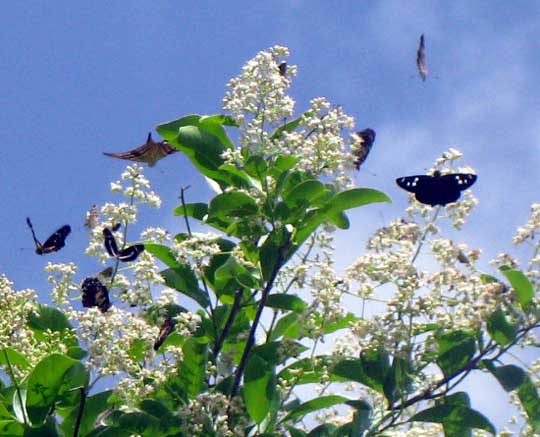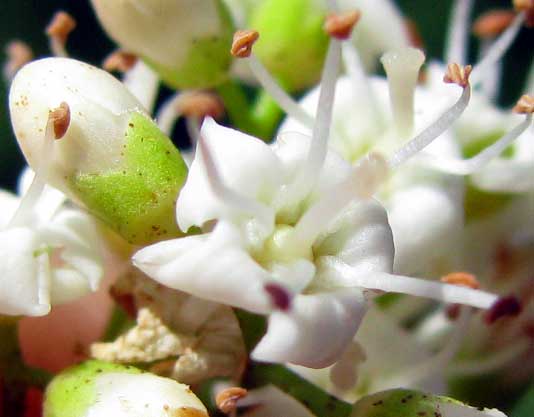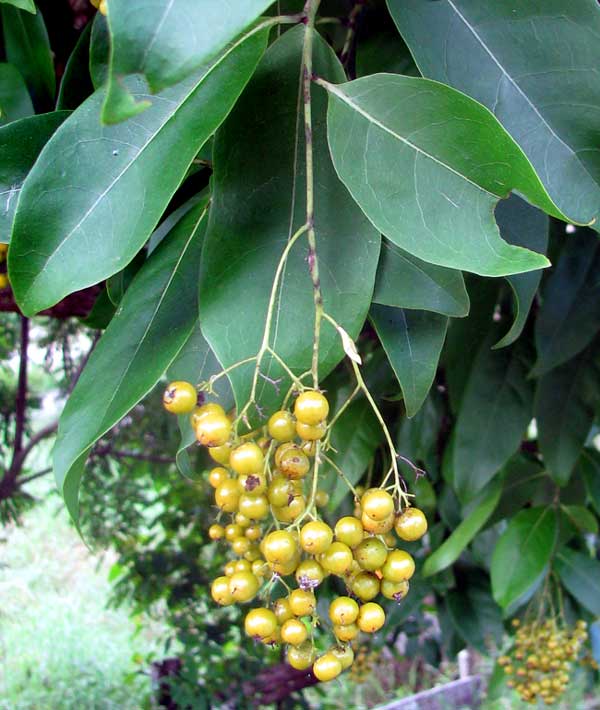Excerpts from Jim Conrad's
Naturalist Newsletter
from the July 4, 2010 Newsletter issued from Hacienda Chichen Resort beside Chichén Itzá Ruins, central Yucatán, MÉXICO; limestone bedrock, elevation ~39m (~128ft), ~N18.52°, ~W95.15°
BECS FLOWERING
Before dawn each morning as I jog past a certain tree for a few seconds my head swims with pleasure as I run through a pool of fragrance made all the sweeter by the morning's moist calmness. It's the Bec tree in full flower.
One afternoon when it was 96° F (35.5° C), very humid but deliciously breezy with fast-moving white cumulus clouds scudding across the blue sky I returned to the fragrant Bec to photograph its flowers. I'd expected the tree's branches to be busy with pollinators but certainly not as full of activity as what I found. I've ever seen a tree more teeming with butterflies, bees and other pollinators than that one. You can see a single, windblown, well butterflied branch high up below:

Bec is EHRETIA TINIFOLIA of the same family in which we find bluebells, forget-me-nots, comfrey and borage, the Borage Family, or Boraginaceae. Bec has flowers typical of the family -- calyx and corolla five-lobed, five stamens inserted on the corolla tube and alternating with the corolla lobes, ovary superior... You can see all these details in the flower shown below:

Standing in the sun and wind that day immersed in Bec's perfume and universe of flitting pollinators, I thought that seldom had I seen an organism more generously and beautifully engaged in community service than that tree.
from the November 15, 2009 Newsletter issued from Hacienda Chichen Resort beside Chichén Itzá Ruins, central Yucatán, MÉXICO; limestone bedrock, elevation ~39m (~128ft), ~N18.52°, ~W95.15°
BECS FRUITING
These days a medium-size tree is drawing attention to itself because of its drooping clusters of pea-sized, golden-yellow fruits, which look very pretty against their background of dark green leaves, as seen below:

The Yucatec Maya call this Bec and elsewhere in Mexico sometimes it's called Pingüico. Both of these names are more felicitous than the only English name I can find for it, which is Bastard Cherry. It's EHRETIA TINIFOLIA, a member of the Borage Family.
My books say that the fruits are edible, but my Maya friends say that only the birds eat them. I find them with so little tasteless flesh around their two hard seeds that I can't imagine anyone eating them unless they were starving. The books also say that the Maya traditionally used the fruits, leaves and roots for a concoction to cure kidney problems. My friends say that it's used for several ailments, but only the old folks know which ailments and how to prepare the medicine.